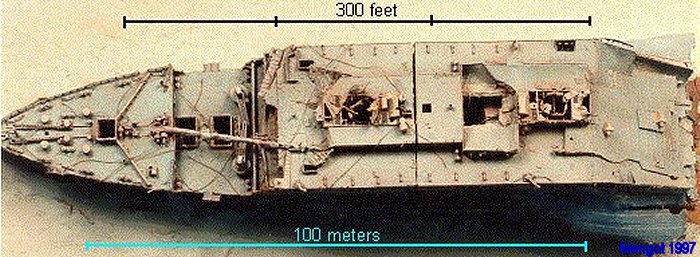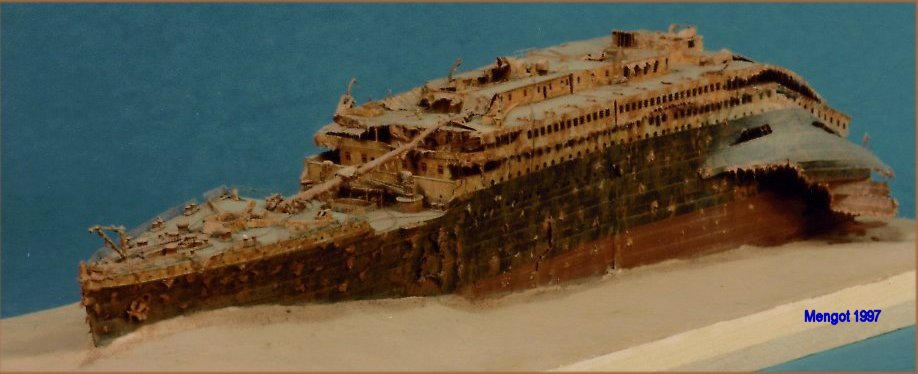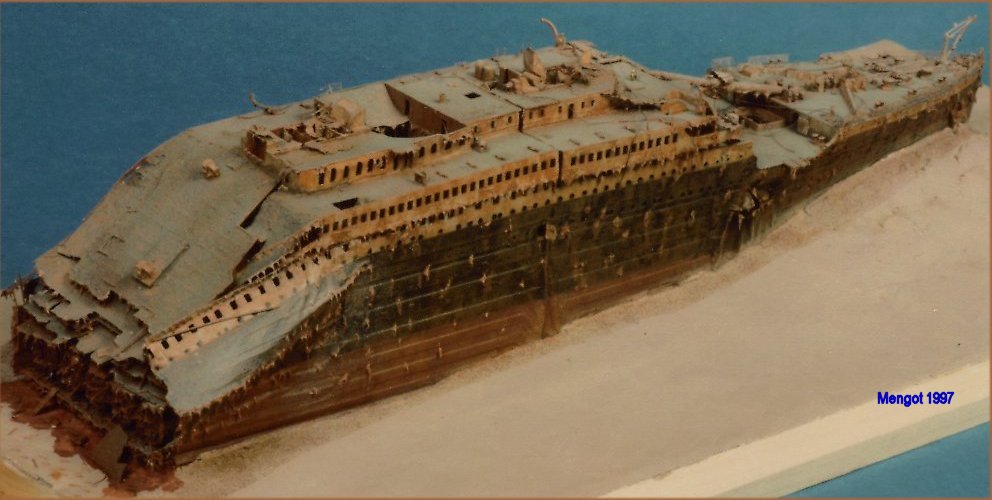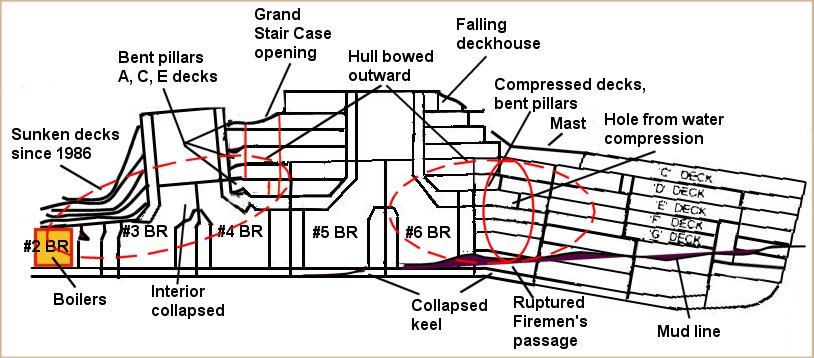

Port1 - aft Port 2 Port 3 - fore |
Tear area Grand Staircase Bridge #1 funnel Well deck Forecastle |
Starboard 1 - aft Starboard 2 Starboard 3 Starboard 4 |
The bow section is dug into the bottom roughly 60 feet (18 meters) at the anchors. At the rear it sits almost on top of the mud, fully exposed. How did this elegant liner end up as it did? Consult the sections on the sinking and the breakup.
The bow section is 450 feet long (137 meters long). That's a LONG city block. It stands 11 stories tall at the #2 funnel. That's the forward half of the ship.

In examining the bow section we have the illusion of the grand and clean lines of the ship but also the subtle devastation that makes the wreck a permanent possession of the sea.
The bow section broke free of the stern section at the surface and began the five minute journey to the bottom. It didn't "plane away" and fly through the water on it's sleek lines to arrive 1970 feet (600 meters) from the stern section. Rather it began a tip and level sequence. It would tip forward, its bow being slightly more hydrodynamic and it's forward speed reaching 10 knots, and then it would level out again to fall nearly flat. This sequence repeated itself several times until impact, when the ship happened to be more tipped forward. The drop is so great that an average forward speed of 5-6 knots gets you the 2000 feet (600 meters) separation between the bow and the center of the wreck site. The fall-to-travel ratio was 6-1.
The bow didn't impact with the bottom the way a plane might plow in. Tilted at a steep angle, the tip of the bow impacted with the bottom first but the inertia of 30,000 tons kept the remainder of the bow section falling on the original, almost vertical line, driving the tip of the bow forward and deeper into the mud. The rear of the bow section hit the bottom at a speed of 25-30 mph.
The impact also caused two bends in the hull. The forward bend under the well deck cranes was estimated by Dr. Robert Ballard at about 6 degrees. Ken Marschall claimed the more recent views by James Cameron in filming the movie "Titanic" showed the cranes were cocked at more like a 10 degree angle.

The second bend under the forward expansion joint is about 4 degrees. Both bends represent a portion of the keel that has been compressed and the decks above are deformed corresponding to their level above the keel and the degree of bend. Together this indicates that the keel is fractured in two places. This makes raising the bow section for salvage extremely difficult, if not impossible.

This drawing shows a structural view of the ship as we know it today and highlights the key areas of internal damage. Compare this to some of the drawings based on the 1986 data shown elsewhere on this site. The decks aft of the #2 funnel are no longer fairly straight and the entire #2 funnel uptake structure has sunken partially into the ship. The gymnasium roof and floor have sunken into A-deck. Explorations down the Grand Stair Case have found that every other deck (A, C, E decks) suffer compression damage in the form of bent pillars that are no longer providing effective support within the ship. An attempt to model the current shape of the ship needs to have the hull sides bow outward in large oval areas around the #2 funnel and forward well deck. Ken Marschall mentions in his notes on his dives to the wreck that the vertical bends in the hull were his guess for his paintings as to how the ship bent in the forward areas on impact. The 1986 data did not show those areas well and I made the same guess. Either way, the shell plating is separated from the decks over wide areas of the hull.
Something the model does not show is interior damage. In the #3 hold along the keel is the Fireman's Passage. It was a watertight tunnel through the hold and it was completely ruptured during the bend on impact. In Scotland Road, the main passage along E-deck, the pillars are significantly bent and pipes are broken and hanging. The hull sides also have small ripples that are difficult to see with the naked eye. In the future, the whole area from the Grand Staircase aft will collapse because the internal structural integrity is compromised.
Copyright 2012 Roy Mengot